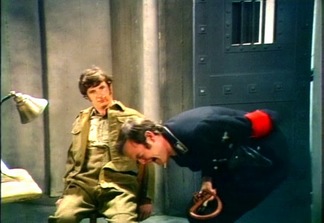Written by Joel T. Lewis I’m not going to say anything new about the comedy troupe Monty Python. Frankly, their work has been basic comedy currency since their first appearances on The Frost Report (1966-67), At Last the 1948 Show (1967), and Do Not Adjust Your Set (1967-69). Graham Chapman, John Cleese, Terry Gilliam, Eric Idle, Terry Jones, and Michael Palin redefined the genre of sketch comedy with Monty Python’s Flying Circus. Their stream-of-consciousness transitions, deconstruction of television’s boundaries, and surreal melding of film, live studio performance, and animation mark the Python team as innovators of the medium of film itself. Now this is not going to be a Series Retrospective in the traditional sense; I believe it would be counterintuitive to attempt an episode-to-episode recap/review style analysis of Flying Circus simply because that sort of examination is ill-suited to breaking down what “happens” when we watch this series. Rather, I will try and break down individual sketches, devices of the series, characters, and themes in each episode that I find particularly interesting. Series 1 Episode 1 Whither Canada Sketch List Famous Deaths with Wolfgang Amadeus Mozart Italian Lessons Whizzo Butter It’s the Arts Picasso on a Bicycle The Killer Joke It’s difficult to express what was going through my mind the very first time I watched “Whither Canada”. I had seen Holy Grail and thought I had a vague sense of who the Monty Python team was and what they were about. I was mistaken. I could not process what I was seeing on the screen. There were men in drag, and pigs, and vaudeville music playing in the background as Victorian era artwork was made to dance and stretch in and out of frame…and more pigs. It was clever, it was zany, it was incredibly silly, and I had never seen anything like it. To this day, “Whither Canada” remains my favorite episode of Flying Circus and the Killer Joke Sketch encapsulates a lot of what I love about this series. The premise is a simple one: what if a joke was so funny that it was lethal? However, it is the extreme to which this premise is pushed that makes the sketch remarkable. Not only does this sketch create a world in which jokes can be lethal, but it takes the premise so seriously and examines this world so closely that it makes you laugh. The sketch poses questions that would arise in the world of the killer joke and answers them matter-of-factly: Q – What precautions would the police have in place when removing a killer joke? A – Naturally, the sound of somber music played on gramophone records and the chanting of laments by the men of Q Division. Q – How the Military go about using the joke in warfare? A – Translate it into German. Q – How do you translate a Lethal Joke? A – With a team of translators working on one word each in “joke-proof” conditions. Q – How do interrogators get information from POW’s in a world of “Joke-Warfare”? A – They tickle them. It is not only the seriousness with which every character in this sketch treats joke-warfare that makes us laugh, however. There are a few sight-gags towards the end of the sketch that create a dissonance in tone, but manage to elevate the sketch rather than take the audience out of the world of Joke-Warfare. The first of these sight-gags comes during the interrogation scene wherein John Cleese is questioning the POW played by Michael Palin. Graham Chapman is dressed as a Gestapo Officer named Otto standing off to the side wearing a sign that labels him “A Gestapo Officer” (even though the audience could have assumed Chapman’s role in this scene based on his uniform alone). Further, Otto claps his hands as Cleese badly mimes slapping Palin. Chapman returns in a later scene in which a Commanding Officer is listening to the most lethal jokes their team of German scientists can devise. Here Chapman has not changed out of Otto’s costume but his sign has been flipped around now showing the label, “A Different Gestapo Officer”. These sight-gags call attention to the audience’s willing participation in the sketch. Of course Otto is a Gestapo Officer, of course in a comedy sketch all of the violence is staged, and of course Chapman’s appearance in a later scene despite the death of Otto in the previous one shows us that he is a different Gestapo Officer; these are all elements of the sketch that the audience would accept as a part of their willing suspension of disbelief. The audience has agreed to take the world of Joke Warfare just as seriously as the sketch does. It seems absurd for the creators of the sketch to have so fully committed to their own premise only to undermine that commitment with these silly sight-gags; however, the sight-gags show that the sketch is also a commentary on the relationship between the television viewer and content creator. For the world of the sketch to work the sketch must take its premise seriously and so must the viewer. As the Killer Joke sketch unfolds both sides of that relationship are fulfilled as we accept that this is how a world of Joke Warfare would work because it is presented so matter-of-factly. The sketch draws attention to things that the audience would have blindly accepted no matter what the opening premise of the sketch was; if a man is wearing a Nazi uniform in a WWII interrogation scene, it stands to reason that he is a Gestapo Officer; if someone is slapped in a scene, obviously there is no actual contact made, and if an actor who’s character dies in a previous scene reappears in a later scene, conventionally, we assume that he is a different character. The sight-gags appear silly but they are in line with how silly the whole premise of the sketch is, and the sketch points out that if we are presented with something as silly as the killer joke in a serious way, we will suspend our disbelief, and that’s funny. Analysis aside the sketch is hilarious; it nails the war documentary genre, the tendency of the armed forces to weaponize anything, and watching the team kick the bucket while laughing is delightful (Cleese’s Woody Woodpecker cackle is particularly funny). Though the German Translation of the Killer Joke: “Wenn ist das Nunstück git und Slotermeyer? Ja! Beiherhund das Oder die Flipperwaldt gersput!” ...is gibberish, the response you get entering it into Google Translate shows the staying power of the Killer Joke premise and the impact Monty Python still has today.
0 Comments
Leave a Reply. |
Archives
April 2025
|
|
© 2012-2025, Nerds That Geek LLC.
All Rights Reserved. |
uWeb Hosting by FatCow

 RSS Feed
RSS Feed